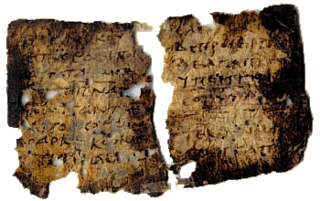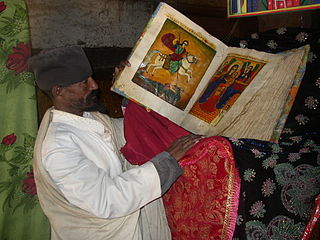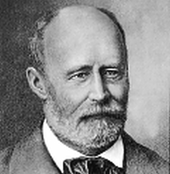
Polycarp was a Christian bishop of Smyrna. According to the Martyrdom of Polycarp, he died a martyr, bound and burned at the stake, then stabbed when the fire failed to consume his body. Polycarp is regarded as a saint and Church Father in the Eastern Orthodox Church, Roman Catholic Church, Oriental Orthodox Churches, Lutheranism, and Anglicanism.

The Didache, also known as The Lord's Teaching Through the Twelve Apostles to the Nations, is a brief anonymous early Christian treatise written in Koine Greek, dated by modern scholars to the first or second century AD.
The Apostolic Fathers, also known as the Ante-Nicene Fathers, were core Christian theologians among the Church Fathers who lived in the 1st and 2nd centuries AD who are believed to have personally known some of the Twelve Apostles or to have been significantly influenced by them. Their writings, though widely circulated in early Christianity, were not included in the canon of the New Testament. Many of the writings derive from the same time period and geographical location as other works of early Christian literature which came to be part of the New Testament.
The Clementine literature is a late antique third-century Christian romance or "novel" containing a fictitious account of the conversion of Clement of Rome to Christianity, his subsequent life and travels with the apostle Peter and an account of how they became traveling companions, Peter's discourses, and finally Clement's family history and eventual reunion with his family. To reflect the pseudonymous nature of the authorship, the author is sometimes referred to as Pseudo-Clement. In all likelihood, the original text went by the name of Periodoi Petrou or Circuits of Peter; sometimes historians refer to it as the "Basic Writing" or "Grundschrift".

The New Testament apocrypha are a number of writings by early Christians that give accounts of Jesus and his teachings, the nature of God, or the teachings of his apostles and of their lives. Some of these writings were cited as scripture by early Christians, but since the fifth century a widespread consensus has emerged limiting the New Testament to the 27 books of the modern canon. Roman Catholic, Eastern Orthodox, and Protestant churches generally do not view the New Testament apocrypha as part of the Bible.

The Armenian Rite is a liturgical rite used by both the Armenian Apostolic and the Armenian Catholic churches. Isaac of Armenia, the Catholicos of All Armenians, initiated a series of reforms with help from Mesrop Mashtots in the 5th century that distinguished Armenia from its Greek and Syriac counterparts. These reforms included a retranslation of the Bible and a revised liturgy. During the Crusades and afterwards, missionary activity by the Latin Church influenced liturgical norms and induced some Armenians to join the Catholic Church. The modern Armenian Rite features elements and interpolations from the Byzantine Rite and Latin liturgical rites, with the celebration of the Eucharist emulating the Liturgy of Saint Basil.

The Apostolic Canons, also called Apostolic canons, Ecclesiastical Canons of the Same Holy Apostles, or Canons of the Holy Apostles, is a 4th-century Syrian Christian text. It is an Ancient Church Order, a collection of ancient ecclesiastical canons concerning the government and discipline of the Early Christian Church, allegedly written by the Apostles. This text is an appendix to the eighth book of the Apostolic Constitutions. Like the other Ancient Church Orders, the Apostolic Canons uses a pseudepigraphic form.
The Apostolic Constitutions or Constitutions of the Holy Apostles is a Christian collection divided into eight books which is classified among the Church Orders, a genre of early Christian literature, that offered authoritative pseudo-apostolic prescriptions on moral conduct, liturgy and Church organization. The work can be dated from 375 to 380 CE. The provenance is usually regarded as Syria, probably Antioch. The author is unknown, although since James Ussher it has been often considered to be the same author as that of the letters of Pseudo-Ignatius, perhaps the 4th-century Eunomian bishop Julian of Cilicia.
Testamentum Domini is a Christian treatise which belongs to the genre of the ancient church orders. The work can be dated to about the 5th-century A.D. even if a 4th-century date is sometimes proposed. The provenience is regarded as Syria, even if also Egypt or Asia Minor are possible origins.
The Apostolic Tradition is an early Christian treatise which belongs to the genre of the ancient Church Orders. It has been described to be of "incomparable importance as a source of information about church life and liturgy in the third century".
The Apostolic Church-Ordinance is an anonymous Oriental Orthodox Christian treatise which belongs to the genre of the Church Orders. The work can be dated at the end of 3rd century CE. The provenance is usually regarded as Egypt, or perhaps Syria.
Edmund Hauler was an Austrian classical philologist born in Ofen to a Danube Swabian German family. His father, Johann Hauler (1829–1888) was also a classical philologist.
The ancient church orders form a genre of early Christian literature, ranging from 1st to 5th century, which has the purpose of offering authoritative "apostolic" prescriptions on matters of moral conduct, liturgy and Church organization. These texts are extremely important in the study of early liturgy and served as the basis for much ancient ecclesiastical legislation.
The Liturgy of the eighth book of the Apostolic Constitutions is a complete text of the Christian Divine Liturgy and found in the eighth book of the Apostolic Constitutions. It is the oldest known form that can be described as a complete liturgy and can be dated to the second half of the 4th century. It belongs to the Antiochene Rite.
The Verona Palimpsest is a manuscript, dated about the 494 AD, which contains a Christian collection of Church Orders in Latin. The manuscript, which contains many lacunae, is the only source of the Latin version of the Apostolic Tradition.

The Orthodox Tewahedo biblical canon is a version of the Christian Bible used in the two Oriental Orthodox Churches of the Ethiopian and Eritrean traditions: the Ethiopian Orthodox Tewahedo Church and the Eritrean Orthodox Tewahedo Church. At 81 books, it is the largest and most diverse biblical canon in traditional Christendom.
Richard Hugh Connolly was a monk of Downside Abbey in Somerset, England, and a patristic scholar who was a major contributor to Syriac scholarship.
Traditionis custodes is an apostolic letter issued motu proprio by Pope Francis, promulgated on 16 July 2021 regarding the continued use of pre-Vatican II rites. It restricts the celebration of the Tridentine Mass of the Roman Rite, sometimes colloquially called the "Latin Mass" or the "Traditional Latin Mass". The apostolic letter was accompanied by an ecclesiastical letter to the Catholic bishops of the world.
Bruno Steimer is a German historian of Christianity, especially early Christianity in the Roman era.
Liturgical use of Latin is the practice of performing Christian liturgy in Ecclesiastical Latin, typically in the liturgical rites of the Latin Church.






